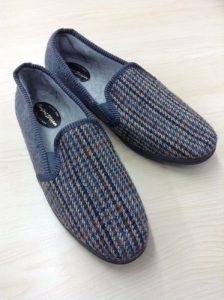50 Objects for 50 years. No. 19. Slippers
The rescue of Cinderella from poverty and abuse relies on footwear. As the tale of the use of the everyday as a vehicle for social advancement, a transformation in circumstances, can be seen as a metaphor, it is to slippers that we turn for Object No 19.
Picture of a pair of the slippers, preserved in the OU Archive
 When the OU moved to Milton Keynes in October 1969, the campus site rapidly became what, as has been noted earlier, one of the earlier staff, Joan Christodoulou called ‘a sea of mud’. To protect the carpets in the new buildings, the Purchasing Officer went to Northampton and bought 100 pairs of carpet slippers for staff to use indoors. These became a symbol for the staff some of whom saw themselves as the pioneers. When the OU ran a project to collect the recollections of staff and students, the oral historian who conducted the interviews noted that the story of the slippers was one of the most frequently told tales. See Hilary Young in her article, ‘Whose story counts? Constructing an oral history of the Open University at 40’, Oral History, 39:2 (Autumn 2011). The footwear came to represent a spirit of dogged fortitude. Although he was born in 1944 Christopher Harvie, who started his OU career in 1969 as a lecturer in history, referred to the propaganda of the war when he noted that:
When the OU moved to Milton Keynes in October 1969, the campus site rapidly became what, as has been noted earlier, one of the earlier staff, Joan Christodoulou called ‘a sea of mud’. To protect the carpets in the new buildings, the Purchasing Officer went to Northampton and bought 100 pairs of carpet slippers for staff to use indoors. These became a symbol for the staff some of whom saw themselves as the pioneers. When the OU ran a project to collect the recollections of staff and students, the oral historian who conducted the interviews noted that the story of the slippers was one of the most frequently told tales. See Hilary Young in her article, ‘Whose story counts? Constructing an oral history of the Open University at 40’, Oral History, 39:2 (Autumn 2011). The footwear came to represent a spirit of dogged fortitude. Although he was born in 1944 Christopher Harvie, who started his OU career in 1969 as a lecturer in history, referred to the propaganda of the war when he noted that:
the campus was so covered in mud that people had to trample around in welly boots. People were issued with slippers when they went into the teaching rooms. Walter Perry greeted us like Trevor Howard in a Second World War movie. He said, ‘Some of you chaps might be wondering why you have been brought here.’
The story of the slippers appeared in an obituary of the first Vice Chancellor, Walter Perry and in the New Scientist article marking the 10th anniversary of the OU. Some staff treasured their slippers and a pair of the original carpet slippers issued to staff were donated to the Archive by Peter Price, Clerk to the Council, on his retirement in 1997.
It might attach too much weight to these items to see the slippers acting as a signal indicating the approach of the early OU to learning and teaching, that just as the sole needs to be embraced by a protective surround, so also does the soul. However, they are a reminder that the OU was opened in a hurry. It was just six years since Wilson had proposed the idea of a university of the air. A university of the air needed an earthbound embodiment but there had been little time to construct physical buildings amidst all the planning of pedagogy, the creation of organisational structures and the recruitment of staff. The slippers helped to preserve the flooring, but also indicated that this was an institution which valued the comfort of its staff. It also recognised thst it could learn from everyday experiences. Just as the OU was being beamed into living rooms via the BBC, so familiar objects from the living room were available at its headquarters. Prospective learners were offered a message that education was not provided just by aloof theoreticians in ivory towers, it was constructed by people in comfy slippers.